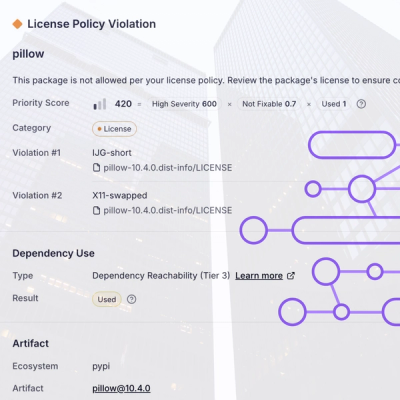
Research
/Security News
Critical Vulnerability in NestJS Devtools: Localhost RCE via Sandbox Escape
A flawed sandbox in @nestjs/devtools-integration lets attackers run code on your machine via CSRF, leading to full Remote Code Execution (RCE).
.. image:: https://raw.githubusercontent.com/hyriver/HyRiver-examples/main/notebooks/_static/async_retriever_logo.png :target: https://github.com/hyriver/HyRiver
|
.. image:: https://joss.theoj.org/papers/b0df2f6192f0a18b9e622a3edff52e77/status.svg :target: https://joss.theoj.org/papers/b0df2f6192f0a18b9e622a3edff52e77 :alt: JOSS
|
.. |pygeohydro| image:: https://github.com/hyriver/pygeohydro/actions/workflows/test.yml/badge.svg :target: https://github.com/hyriver/pygeohydro/actions/workflows/test.yml :alt: Github Actions
.. |pygeoogc| image:: https://github.com/hyriver/pygeoogc/actions/workflows/test.yml/badge.svg :target: https://github.com/hyriver/pygeoogc/actions/workflows/test.yml :alt: Github Actions
.. |pygeoutils| image:: https://github.com/hyriver/pygeoutils/actions/workflows/test.yml/badge.svg :target: https://github.com/hyriver/pygeoutils/actions/workflows/test.yml :alt: Github Actions
.. |pynhd| image:: https://github.com/hyriver/pynhd/actions/workflows/test.yml/badge.svg :target: https://github.com/hyriver/pynhd/actions/workflows/test.yml :alt: Github Actions
.. |py3dep| image:: https://github.com/hyriver/py3dep/actions/workflows/test.yml/badge.svg :target: https://github.com/hyriver/py3dep/actions/workflows/test.yml :alt: Github Actions
.. |pydaymet| image:: https://github.com/hyriver/pydaymet/actions/workflows/test.yml/badge.svg :target: https://github.com/hyriver/pydaymet/actions/workflows/test.yml :alt: Github Actions
.. |pygridmet| image:: https://github.com/hyriver/pygridmet/actions/workflows/test.yml/badge.svg :target: https://github.com/hyriver/pygridmet/actions/workflows/test.yml :alt: Github Actions
.. |pynldas2| image:: https://github.com/hyriver/pynldas2/actions/workflows/test.yml/badge.svg :target: https://github.com/hyriver/pynldas2/actions/workflows/test.yml :alt: Github Actions
.. |async| image:: https://github.com/hyriver/async-retriever/actions/workflows/test.yml/badge.svg :target: https://github.com/hyriver/async-retriever/actions/workflows/test.yml :alt: Github Actions
.. |signatures| image:: https://github.com/hyriver/hydrosignatures/actions/workflows/test.yml/badge.svg :target: https://github.com/hyriver/hydrosignatures/actions/workflows/test.yml :alt: Github Actions
================ ==================================================================== Package Description ================ ==================================================================== PyNHD_ Navigate and subset NHDPlus (MR and HR) using web services Py3DEP_ Access topographic data through National Map's 3DEP web service PyGeoHydro_ Access NWIS, NID, WQP, eHydro, NLCD, CAMELS, and SSEBop databases PyDaymet_ Access daily, monthly, and annual climate data via Daymet PyGridMET_ Access daily climate data via GridMET PyNLDAS2_ Access hourly NLDAS-2 data via web services HydroSignatures_ A collection of tools for computing hydrological signatures AsyncRetriever_ High-level API for asynchronous requests with persistent caching PyGeoOGC_ Send queries to any ArcGIS RESTful-, WMS-, and WFS-based services PyGeoUtils_ Utilities for manipulating geospatial, (Geo)JSON, and (Geo)TIFF data ================ ====================================================================
.. _PyGeoHydro: https://github.com/hyriver/pygeohydro .. _AsyncRetriever: https://github.com/hyriver/async-retriever .. _PyGeoOGC: https://github.com/hyriver/pygeoogc .. _PyGeoUtils: https://github.com/hyriver/pygeoutils .. _PyNHD: https://github.com/hyriver/pynhd .. _Py3DEP: https://github.com/hyriver/py3dep .. _PyDaymet: https://github.com/hyriver/pydaymet .. _PyGridMET: https://github.com/hyriver/pygridmet .. _PyNLDAS2: https://github.com/hyriver/pynldas2 .. _HydroSignatures: https://github.com/hyriver/hydrosignatures
.. image:: https://img.shields.io/pypi/v/async-retriever.svg :target: https://pypi.python.org/pypi/async-retriever :alt: PyPi
.. image:: https://img.shields.io/conda/vn/conda-forge/async-retriever.svg :target: https://anaconda.org/conda-forge/async-retriever :alt: Conda Version
.. image:: https://codecov.io/gh/hyriver/async-retriever/branch/main/graph/badge.svg :target: https://codecov.io/gh/hyriver/async-retriever :alt: CodeCov
.. image:: https://img.shields.io/pypi/pyversions/async-retriever.svg :target: https://pypi.python.org/pypi/async-retriever :alt: Python Versions
.. image:: https://static.pepy.tech/badge/async-retriever :target: https://pepy.tech/project/async-retriever :alt: Downloads
|
.. image:: https://img.shields.io/badge/security-bandit-green.svg :target: https://github.com/PyCQA/bandit :alt: Security Status
.. image:: https://www.codefactor.io/repository/github/hyriver/async-retriever/badge :target: https://www.codefactor.io/repository/github/hyriver/async-retriever :alt: CodeFactor
.. image:: https://img.shields.io/endpoint?url=https://raw.githubusercontent.com/astral-sh/ruff/main/assets/badge/v2.json :target: https://github.com/astral-sh/ruff :alt: Ruff
.. image:: https://img.shields.io/badge/pre--commit-enabled-brightgreen?logo=pre-commit&logoColor=white :target: https://github.com/pre-commit/pre-commit :alt: pre-commit
|
AsyncRetriever is a part of HyRiver <https://github.com/hyriver/HyRiver>__ software stack that
is designed to aid in hydroclimate analysis through web services. This package serves as HyRiver's
engine for asynchronously sending requests and retrieving responses as text, binary, or
json objects. It uses persistent caching using
aiohttp-client-cache <https://aiohttp-client-cache.readthedocs.io>__ to speed up the retrieval
even further. Moreover, thanks to nest_asyncio <https://github.com/erdewit/nest_asyncio>__
you can use this package in Jupyter notebooks. Although this package is part of the HyRiver
software stack, it can be used for any web calls. There are three functions that you can
use to make web calls:
retrieve_text: Get responses as text objects.retrieve_binary: Get responses as binary objects.retrieve_json: Get responses as json objects.stream_write: Stream responses and write them to disk in chunks.You can also use the general-purpose retrieve function to get responses as any
of the three types. All responses are returned as a list that has the same order as the
input list of requests. Moreover, there is another function called delete_url_cache
for removing all requests from a cache file that contains a given URL.
You can control the request/response caching behavior and verbosity of the package by setting the following environment variables:
HYRIVER_CACHE_NAME: Path to the caching SQLite database. It defaults to
./cache/aiohttp_cache.sqliteHYRIVER_CACHE_EXPIRE: Expiration time for cached requests in seconds. It defaults to
one week.HYRIVER_CACHE_DISABLE: Disable reading/writing from/to the cache. The default is false.HYRIVER_SSL_CERT: Path to a SSL certificate file.For example, in your code before making any requests you can do:
.. code-block:: python
import os
os.environ["HYRIVER_CACHE_NAME"] = "path/to/file.sqlite"
os.environ["HYRIVER_CACHE_EXPIRE"] = "3600"
os.environ["HYRIVER_CACHE_DISABLE"] = "true"
os.environ["HYRIVER_SSL_CERT"] = "path/to/cert.pem"
You can find some example notebooks here <https://github.com/hyriver/HyRiver-examples>__.
You can also try using AsyncRetriever without installing it on your system by clicking on the binder badge. A Jupyter Lab instance with the HyRiver stack pre-installed will be launched in your web browser, and you can start coding!
Moreover, requests for additional functionalities can be submitted via
issue tracker <https://github.com/hyriver/async-retriever/issues>__.
If you use any of HyRiver packages in your research, we appreciate citations:
.. code-block:: bibtex
@article{Chegini_2021,
author = {Chegini, Taher and Li, Hong-Yi and Leung, L. Ruby},
doi = {10.21105/joss.03175},
journal = {Journal of Open Source Software},
month = {10},
number = {66},
pages = {1--3},
title = {{HyRiver: Hydroclimate Data Retriever}},
volume = {6},
year = {2021}
}
You can install async-retriever using pip:
.. code-block:: console
$ pip install async-retriever
Alternatively, async-retriever can be installed from the conda-forge repository
using Conda <https://docs.conda.io/en/latest/>__:
.. code-block:: console
$ conda install -c conda-forge async-retriever
AsyncRetriever by default creates and/or uses ./cache/aiohttp_cache.sqlite as the cache
that you can customize by the cache_name argument. Also, by default, the cache doesn't
have any expiration date and the delete_url_cache function should be used if you know
that a database on a server was updated, and you want to retrieve the latest data.
Alternatively, you can use the expire_after to set the expiration date for the cache.
As an example for retrieving a binary response, let's use the DAAC server to get
NDVI <https://daac.ornl.gov/VEGETATION/guides/US_MODIS_NDVI.html>_.
The responses can be directly passed to xarray.open_mfdataset to get the data as
a xarray Dataset. We can also disable SSL certificate verification by setting
ssl=False.
.. code-block:: python
import io
import xarray as xr
import async_retriever as ar
from datetime import datetime
west, south, east, north = (-69.77, 45.07, -69.31, 45.45)
base_url = "https://thredds.daac.ornl.gov/thredds/ncss/ornldaac/1299"
dates_itr = ((datetime(y, 1, 1), datetime(y, 1, 31)) for y in range(2000, 2005))
urls, kwds = zip(
*[
(
f"{base_url}/MCD13.A{s.year}.unaccum.nc4",
{
"params": {
"var": "NDVI",
"north": f"{north}",
"west": f"{west}",
"east": f"{east}",
"south": f"{south}",
"disableProjSubset": "on",
"horizStride": "1",
"time_start": s.strftime("%Y-%m-%dT%H:%M:%SZ"),
"time_end": e.strftime("%Y-%m-%dT%H:%M:%SZ"),
"timeStride": "1",
"addLatLon": "true",
"accept": "netcdf",
}
},
)
for s, e in dates_itr
]
)
resp = ar.retrieve_binary(urls, kwds, max_workers=8, ssl=False)
data = xr.open_mfdataset(io.BytesIO(r) for r in resp)
We can remove these requests and their responses from the cache like so:
.. code-block:: python
ar.delete_url_cache(base_url)
.. image:: https://raw.githubusercontent.com/hyriver/HyRiver-examples/main/notebooks/_static/ndvi.png :target: https://github.com/hyriver/HyRiver-examples/blob/main/notebooks/async.ipynb
For a json response example, let's get water level recordings of an NOAA's water level station,
8534720 (Atlantic City, NJ), during 2012, using CO-OPS API. Note that this CO-OPS product has a
31-day limit for a single request, so we have to break the request down accordingly.
.. code-block:: python
import pandas as pd
station_id = "8534720"
start = pd.to_datetime("2012-01-01")
end = pd.to_datetime("2012-12-31")
s = start
dates = []
for e in pd.date_range(start, end, freq="m"):
dates.append((s.date(), e.date()))
s = e + pd.offsets.MonthBegin()
url = "https://api.tidesandcurrents.noaa.gov/api/prod/datagetter"
urls, kwds = zip(
*[
(
url,
{
"params": {
"product": "water_level",
"application": "web_services",
"begin_date": f'{s.strftime("%Y%m%d")}',
"end_date": f'{e.strftime("%Y%m%d")}',
"datum": "MSL",
"station": f"{station_id}",
"time_zone": "GMT",
"units": "metric",
"format": "json",
}
},
)
for s, e in dates
]
)
resp = ar.retrieve_json(urls, kwds)
wl_list = []
for rjson in resp:
wl = pd.DataFrame.from_dict(rjson["data"])
wl["t"] = pd.to_datetime(wl.t)
wl = wl.set_index(wl.t).drop(columns="t")
wl["v"] = pd.to_numeric(wl.v, errors="coerce")
wl_list.append(wl)
water_level = pd.concat(wl_list).sort_index()
water_level.attrs = rjson["metadata"]
.. image:: https://raw.githubusercontent.com/hyriver/HyRiver-examples/main/notebooks/_static/water_level.png :target: https://github.com/hyriver/HyRiver-examples/blob/main/notebooks/async.ipynb
Now, let's see an example without any payload or headers. Here's how we can retrieve harmonic constituents of several NOAA stations from CO-OPS:
.. code-block:: python
stations = [
"8410140",
"8411060",
"8413320",
"8418150",
"8419317",
"8419870",
"8443970",
"8447386",
]
base_url = "https://api.tidesandcurrents.noaa.gov/mdapi/prod/webapi/stations"
urls = [f"{base_url}/{i}/harcon.json?units=metric" for i in stations]
resp = ar.retrieve_json(urls)
amp_list = []
phs_list = []
for rjson in resp:
sid = rjson["self"].rsplit("/", 2)[1]
const = pd.DataFrame.from_dict(rjson["HarmonicConstituents"]).set_index("name")
amp = const.rename(columns={"amplitude": sid})[sid]
phase = const.rename(columns={"phase_GMT": sid})[sid]
amp_list.append(amp)
phs_list.append(phase)
amp = pd.concat(amp_list, axis=1)
phs = pd.concat(phs_list, axis=1)
.. image:: https://raw.githubusercontent.com/hyriver/HyRiver-examples/main/notebooks/_static/tides.png :target: https://github.com/hyriver/HyRiver-examples/blob/main/notebooks/async.ipynb
Contributions are appreciated and very welcomed. Please read
CONTRIBUTING.rst <https://github.com/hyriver/async-retriever/blob/main/CONTRIBUTING.rst>__
for instructions.
FAQs
High-level API for asynchronous requests with persistent caching.
We found that async-retriever demonstrated a healthy version release cadence and project activity because the last version was released less than a year ago. It has 1 open source maintainer collaborating on the project.
Did you know?

Socket for GitHub automatically highlights issues in each pull request and monitors the health of all your open source dependencies. Discover the contents of your packages and block harmful activity before you install or update your dependencies.

Research
/Security News
A flawed sandbox in @nestjs/devtools-integration lets attackers run code on your machine via CSRF, leading to full Remote Code Execution (RCE).

Product
Customize license detection with Socket’s new license overlays: gain control, reduce noise, and handle edge cases with precision.

Product
Socket now supports Rust and Cargo, offering package search for all users and experimental SBOM generation for enterprise projects.